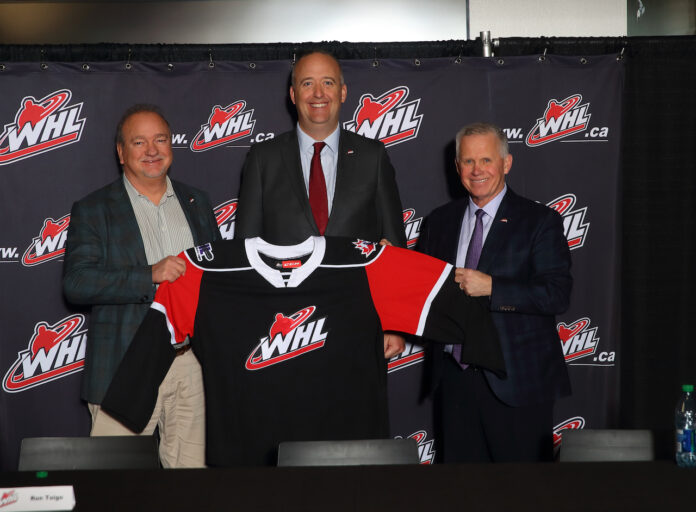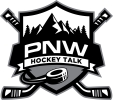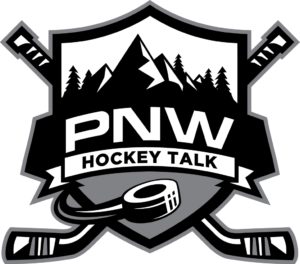
One of the perks of covering the 2024 Memorial Cup in Saginaw, Michigan, is meeting a variety of people from the hockey and junior hockey worlds.
Earlier this week, the Western Hockey League gave me an exclusive opportunity to sit down with Dan Near, the new commissioner, for 15 minutes before Moose Jaw played Drummondville. Since our time was limited, we were only able to touch on a few topics. That said, Dan was very thorough with his answers and very personable.
Similar to how I’ve presented my conversations with Portland Winterhawks owner Michael Kramer in our ‘State of the Org” updates, I will provide my conversation with the new WHL commissioner in a question-and-answer format. This allows everyone to read what I asked and how Dan answered rather than me putting any unintentional personal spin on the conversation.
I would like to thank both Dan and the WHL for giving me this opportunity, and I look forward to continuing our conversation in the future.
Josh Critzer – How has your tenure as the new WHL Commissioner been so far?
Dan Near – “I think it has been a little overwhelming. There is such massive tradition and history around this league, around this sport, around the CHL, and to be here celebrating my first Memorial Cup is a pretty special moment. I’ve been in the hockey business for a number of years and have been at the very biggest events. At the same time, there is no event that’s bigger to its local community, to the Western Hockey League, and to the Canadian Hockey League. What I saw in Moose Jaw when they raised the trophy, not what the fans in the Pacific Northwest of the United States wanted to see, it was a really special moment.
It is a little bit of a transition for me. My career has gone from growing up in Toronto, to having a chance to work with the National Hockey League in New York for ten years, to spending eight years at Adidas leading their hockey business, to now going to a property that I wouldn’t call an underdog, but it is certainly entrepreneurial. We certainly have to work for everything that we get. I’m really, really proud to be part of it and loving every moment being part of it. The beauty of it is there is so much upside to this league. There is so much upside to major junior hockey. There is so much upside as it relates to storytelling and educating fans about the players’ journey and their stories. That is something I’m excited to be part of.”
What are some of the things you are prioritizing, or how are you looking to put your own stamp on the league?
Near – “First is not jumping to a conclusion that we need to change everything. I’m a little bit of a different profile. We’ve had a fantastic commissioner in Ron Robison, who has steered the ship for 24 years. I think if you were to come in and say, ‘You need to change everything,’ you are probably pretty naive or your ego is a little too big. There is a lot of really good in what we do now. I think we are the best development league in the world. I think the player experience we deliver is unmatched, not just across major junior leagues but junior hockey leagues in the U.S. and the NCAA experience. Our player experience is really, really unique. This idea that you’re going to play for one of our teams and be under their wing, living with a billet family, having these professionally curated environments as far as training facilities and coaching that have been at the highest level of the game, to get that for four or five years, for each year you’re playing you’re earning a year scholarship. You are then getting a chance to go play at University in Canada or go to college in the US and have the CHL team, or the WHL team you played for underwrite that experience, this is incredible. This idea that going in with a mindset that I need to change a bunch of things would be flawed; let me start with that.
At the same time, I think that the fan is evolving. The marketplace is evolving. We are probably perceived as a mature league or one that is really caught up in history and tradition in a way that may be unhealthy to some extent. The stamp that I hope I can leave on it is to say, ‘Hey, what are some of the things that are going on with the marketplace, with the consumer, with the fans?’ How do they want to take in the sport? Are we an entertainment property or a development property? We are both, right? We have to illustrate that to the fan and the consumer. It is different in Portland than it is in Moose Jaw. If you did an analysis of the percentage of fans who are in the building on any given night who played hockey growing up, it is vastly different. You don’t need to be a rocket scientist to figure that part out. When you start to think about that dynamic, and why people are there, and what they are there for, and what their experience is like, it is different in each market. I think being open-minded around that, staying committed to delivering the ultimate player experience, staying committed to being the best development league in the world, but this idea of starting to scale our behaviors a little bit.

We are very, very locally-centric in that the clubs are really doing what they think is best for their audience. There are a lot of great things happening around the league that I would like to see us try and scale. What I mean is what is happening in Portland could also happen in Spokane, despite that you are U.S. Division rivals, you are not competitors. You are competitors on the ice, and the fans are competitive with one another, but if there is a good idea in Portland, someone else in the U.S. Division could leverage that. Similarly, if Swift Current, Moose Jaw, and Prince Albert, three community-owned teams in Canada, what are they doing amongst each other to make each other better, to make each other more competitive on the ice, and really bring more attention?
An example of that I would say, that is a big goal of my mine, is how do we story tell around what is going on outside of the home market? I don’t want a single Winterhawks fan, or a single fan of any given team, to decrease their fandom towards their home team. I want them to maintain that passion. I also want them to know what is going on around the league. We have to figure out how to serve you highlights. We have to figure out a way to tell stories and learn about the players and what are the other interesting things happening behind the scenes. This idea that Logan Stankoven goes from Kamloops to the American (Hockey) League, and then to the Dallas Stars, and is making an impact on the ice after being in our league. The Connor Bedard thing is obvious. If you look at someone like Logan and say someone like him was playing in our league last year, I should’ve known more about him. If you look at Gavin McKenna and the impact he had at the U18s, the leading scorer at the tournament, set a record as an underage player, and how many fans around the league are currently interested in that and paying attention to that and have access to that story? Landon DuPont coming in as an exceptional player, drafted by Everett, a rival to the Portland Winterhawks. I want the Winterhawks fans to care about what is going on with Landon DuPont because that is part of what makes the league successful and makes the league tick is that we are developing these players to play in the National Hockey League and be good citizens and contributors to the community. It is about this hierarchy around my team, around the league, and how it all translates.”
How about from a streaming perspective? I receive a lot of questions about the quality of the streaming service and the different standards in each building. There is also a lot of disappointment with it. What is the league’s plan to try to improve that or raise the standards across the different buildings? Are there any improvements or enhancements that you want to see?
Near – “I think I would start with that it is my understanding that it has come a long way. I think when you contemplate the availability of junior hockey anywhere, we might be the best as far as the streaming product right now. I don’t know everything that is out there. Having said that, I would endorse what you are saying of this idea if you just talk about how fans are consuming the sport. I have the luxury of having three teenage kids. The way I grew up watching sports from end to end on television, the world is different. I think we acknowledge that, and we are working to get ahead of it.

This idea of standards across our league, whether it is streaming, whether it is facility standards, player experience standards, and ensuring we are operating at what I would characterize as a premium level is important to us. I think that I would be very quick to acknowledge we have room to grow and to develop there. It is not strictly around the existing streaming product to me. It is around the overall level of content we are serving to the fan. The NHL has done something interesting in that they’ve put these content curators in each market out there, capturing photography, talking to players, and seeing what is going on in the stands. They are trying to feed the story connected to the story. The highlights of the game are important, but everything around that is critically important too.
I think we are going to spend a lot of time figuring out how do we ensure we have a product that people want to tune into. One of the things that I think is the biggest concern to me right now is that you have 34 home games, and then the Winterhawks go away. You are fortunate to have a local T.V. package where some of the games can be broadcast locally, but unless someone is purchasing the streaming package, there is a void there. You have thousands of fans that aren’t going to necessarily pay $129 or whatever that number is to subscribe to the streaming. I think we are kind of missing a middle tier. You have the super avid who are buying into it, the super casuals who only go to the home games and pay attention that way, or listen to the radio. The Winterhawks do a great job with that. How do you find that in-betweener? How do you find that fan and serve them with adequate content? We need to not force them to come to us but go where they are. Where are the fans looking for sports content and for hockey content? Let’s make sure our product is available there.
Yes, we are going to elevate our streaming package and try to get to a position where the standards are such that the games feel like they are high quality. Overall, the content we are serving the fans is an area of opportunity for us.”
To be respectful of our time, I will ask you two questions, and you can answer whichever you prefer. How do you feel about the U.S. Prospects Draft and how recruiting Americans is going? The U.S. Prospects Draft is relatively new, so I’m curious to hear your thoughts there. The other is about all the talk around the NCAA/CHL and possibly having CHL players be eligible to play NCAA hockey after they are done in the CHL.
Near – “How about I answer both for you? What I would say about the U.S. Draft is that I think our league is a really viable and fantastic option for U.S.-born players, but we have a little bit of a marketing problem. We have this problem that people perceive the NCAA route to be a better route for an education. That is actually more of a marketing problem than it is a structural problem. Our league is a great place to go. We’ve got education advisors. We have a 100% high school graduation rate. Then, for every year you play in our league, you’ve got a scholarship opportunity. We have some work to do around helping young American players understand that.

Then, connected to that is the eligibility situation. Really, when you think about what is going on in that ecosystem as recently this weekend with the news about paying players so to speak. Let’s get this straight: this is a football and basketball-led situation. Those are revenue sports that are driving millions and millions of T.V. revenues and licensing fees and those kind of things. Hockey doesn’t operate that way. So, I think a lot of people are representing that hockey is suddenly is going to be this windfall for players. I don’t necessarily see it that way. In either event, the idea that our players are ineligible now is probably a dated or antedated approach. Do I know when it is going to change or if it is going to change? I can’t say that for certain, Josh. I think we are likely to see change in the future. I think we are likely to see a situation where that path that’s the best development option for a player from when he’s 16 years old to when he’s 22, 23, or 24 years old probably incorporates both options. Seeing how that all shakes out, when it shakes out, is all TBD.
I’ll tell you that I endorse it. I think that we’re in this to drive the development of players and create the best experience, the best professional opportunity, but also the best oppiornty to be a great citizen. I think a college degree is a big part of that, which happens in the CHL. The NCAA is appealing, especially for an American who grew up watching Notre Dame Football on TV or Oregon Ducks football on TV; I get it. I get it. I’m optimistic about that.
I think the future is bright in that regard. I think we need to be measured and thoughtful in how we get there, but I’m not sitting saying there trying to find reasons this shouldn’t happen.”






